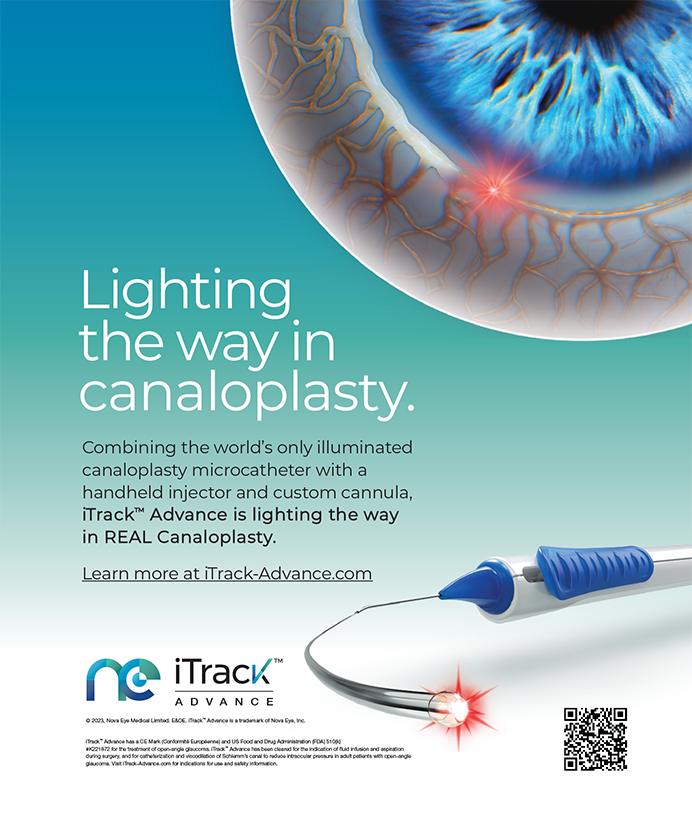Some refractive surgeons shy away from treating hyperopes with laser vision correction, mainly because visual results have been so variable compared with myopic treatments. In the past, surgeons could never really be sure what their outcomes were going to be, especially with mid- and upper-range hyperopes. Another reason they have tended to avoid performing surgery on hyperopes is that these patients often have smaller eyes and eyelids. In some cases, it is extremely difficult to place a microkeratome on the eye; in others, it is almost impossible. A break in suction during such a case could make surgeons hesitant to treat these patients.
I understand this reaction, but two changes altered my outlook on hyperopic treatments. I changed from a mechanical microkeratome to the IntraLase FS Laser (Abbott Medical Optics Inc., Santa Ana, CA). I found that the latter is capable of creating a LASIK flap in all but a very few small eyes. If suction breaks with the IntraLase, the ring can be replaced, and I can proceed with surgery. The second change was my switch from the Visx Star S4 (Abbott Medical Optics Inc.) to the WaveLight Allegretto Q400 (Alcon Laboratories, Inc., Fort Worth, TX).
Since these transitions, hyperopic treatments have kept my LASIK practice robust. I believe other surgeons can realize the same untapped potential in their hyperopic candidates. In my case, hyperopic LASIK treatments now constitute about 40% of my practice. I attribute that growth to my increased confidence in consistently delivering excellent visual results.
RETREATMENTS
By definition, hyperopic ablations take longer than myopic ablations to perform. At 400 pulses per second, the speed of the Allegretto offers a key advantage in hyperopic treatments, as it lets the stroma stay hydrated. In my experience with the Visx, the stroma can start to dry out before the treatment is completed. I firmly believe this is why some very talented surgeons do not have great hyperopic outcomes with this laser, especially with preoperative refractions higher than +2.00 D.
I avoid retreatments for at least 8 months to ensure that, if one is necessary, the refraction has been allowed to stablize. Using the Visx platform, my personal retreatment rates were around 5.6%. They have dropped by more than half—to 2%—with the WaveLight. I have been using this platform for 3 years, and over the long term, I can say results are stable and my retreatment rate continues to decline.
CLINICAL STUDY OUTCOMES
To ensure that my clinical impressions were supported by the data, my colleagues and I conducted a study comparing visual outcomes in hyperopes using the Visx Star S4 or the WaveLight Allegretto Q400; in all cases, we created the LASIK flap with the IntraLase. We targeted either emmetropia or monovision (-2.00 D), and follow-up was at least 6 months. On average, the flap’s thickness was 105 μm, with an average diameter of 9 mm. Outcomes measured included pre- and postoperative refractive errors, BCVA, UCVA, targeted monovision refractive goal, complications, and retreatments.
In the emmetropic group, 67 eyes were treated with the Visx, and 60 were treated with the Allegretto. The results, segmented by level of preoperative hyperopia, are shown in Table 1. Although both groups’ visual acuity results for low hyperopia were similar, significant differences emerged as the level of hyperopia increased. In terms of accuracy to within 0.50 D of emmetropia, the Allegretto showed tighter results at all levels of hyperopic correction.
In the monovision group, 40 eyes were treated with the Visx and 38 eyes with the Allegretto. The results for these eyes are best judged by analyzing the surgeon’s ability to hit the target of -2.00 D (Figure 1).
We needed to re-treat six eyes in the Visx group and two eyes in the Allegretto group. We had no serious complications aside from postoperative dry eye, which was expected. In our hands, the Allegretto Q400 offered a much faster treatment time (5 seconds vs 20 seconds per diopter on the Visx), and it appeared to offer an advantage of shorter treatment times over the Visx platform in moderate-to-high hyperopes.
ADVICE BASED ON MY EXPERIENCE
When considering treating hyperopes, the choice of laser system platform is just as important as how to make a flap or even selecting appropriate patients. If a femtosecond laser is used to create the flap, combining it with the Allegretto will provide excellent outcomes for moderate or high hyperopes, in my experience. There was arguably no learning curve to introducing the Allegretto platform into my practice (each surgeon must develop his or her own nomogram, however). When treating hyoperopes with the Visx platform, my outcomes were quite variable, making it difficult to have a predictable nomogram. My nomograms for myopic patients are much less variable. On the Allegretto, my colleagues and I treat hyperopes directly from their manifest refraction with the results noted previously. To be safe, I recommend treating 10 patients and then seeing if the nomogram needs adjustment.
Being able to offer hyperopic corrections with the same confidence as I can offer myopic corrections has been invaluable to my practice. In today’s economic climate, surgeons need every tool available to maintain profitability. Integrating the Allegretto into my practice has opened up an entirely new set of potential patients.
Albert T. Milauskas, MD, is the founder and medical director of the Milauskas Eye Institute, Palm Springs, California and a clinical professor of ophthalmology at the Jules Stein Eye Institute at UCLA. He serves on an Alcon refractive surgery panel and is a clinical investigator for an Alcon-sponsored FDA investigation of topographically guided LASIK. Dr. Milauskas may be reached at (760) 340-eyes; al2dot@aol.com.


